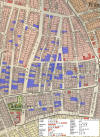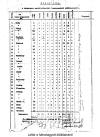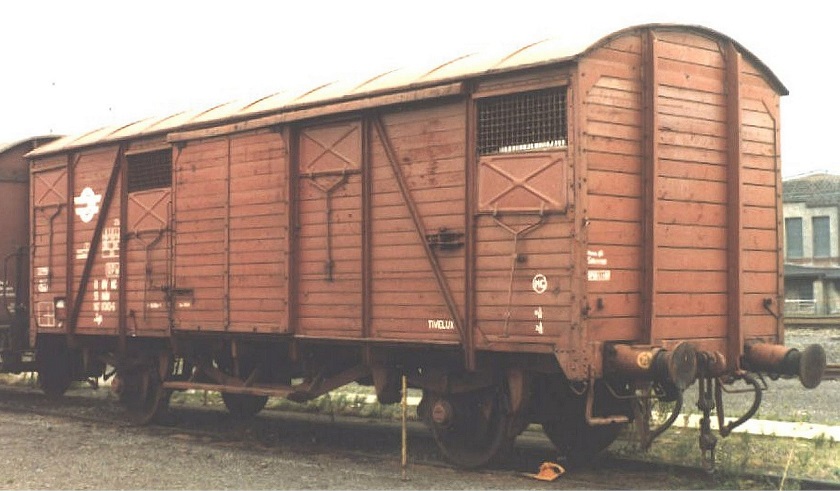04.04.1944, a decree was passed by order of the German authorities, that all Jews were to be detected and registered in a nationwide so-called Jewish census. The list was copied several times for various offices in the whole country. Most of these lists are no longer to be found, with the exception of those in Debrecen, Centre for the VI. Gendarmerie district and also the deportation zone IV.”Jaross list”
06.04.1944 the next anti-Jewish decree was published, demanding all Jewish people above the age of 6 to wear a yellow Star of David at all times they were outside of their homes. The star had to be fixed visibly and irremovably on their clothes.
11.05.1944 an article about the ghetto-like concentration of the Jews in the vicinity of the synagogues was published in the “Körösvidék”. The blue color on the map signifies the Jewish houses, the stars denote the two synagogues.




Our situation deteriorated from day to day, in mid-June all the Jews were relocated in the tobacco drying /marketing company, near the railway. Probably immediately after our move to the ghetto created an inventory was made of the abandoned livestock. In our house ( Gyóni G. 22) four chickens were listed, the animals were sold and the earnings were added to the other confiscated Jewish assets.
When we came to the ghetto, the family was split; my father was drafted into the military forced labor service with several other men. He went as a professional, though he was with his 48 years over the obligatory military service age. The ghetto consisted of eight 42 x 15 m 2-storey buildings on 37’260 sqm, without partitions and very windy. Beside the about 2’500 Jews of the town, also Jews from the county were collected in the ghetto of Békéscsaba. About 4000 persons were concentrated in the ghetto. Place beside the one our straw mattress or mattress occupied, was none. We were allowed to take only the bare essentials that we could carry ourselves.
We suffered from hunger, lack of space and extremely cruel treatment by guards and police. If we are already missing at the concentration in Jewish houses of privacy, here there was even less. Hygienic conditions were indescribable, instead of toilets there were latrines, dug ditches with a bar, it was bad for the younger ones, but horrible for the older people. Sometimes it has happened that people lost their balance and fell into the latrine. Interrogations with sadistic tortures against the wealthy women were common (men were in the labor service) to come so hidden money, jewelry and valuables on the track. So my mother had to tell to whom did she give her astrakhan coat for storage.
On June 25, they were looking for volunteers for the first deportation transport. They found none, so a barrack was closed down – mostly with families from the surrounding villages – and few from Békéscsaba. They were embarked and – as it turned out later – brought to the ghetto Debrecen. There they stayed for a short time and the transport was divided. Some were brought to Austria, Wiener Neustadt / Strasshof, along with people from the ghetto Debrecen. The other part, again with inmates of the ghetto Debrecen to Auschwitz. Most of the deportees to Austria survived the war, but only few from the ones who were taken to Auschwitz.
The next day , on 26 June , the rest of the ghetto inmates were embarked and taken to Auschwitz – 20 days after the Allies landed successfully in Normandy (6 June 1944) – .. Between 80 to 95 people were in closed freight cars (also used for livestock transport) supplied only with a bucket for toilet and one with drinking water. The cars were locked; even the window openings were secured with barbed wire.

Our first stop was in Kassa (Košice), which was the transfer station where the Hungarian Gendarmerie was replaced by German guards. We were able to fetch fresh water and empty the toilet buckets. The Hungarian guards told us that we were leaving the country and that all valuables must be surrendered to them, otherwise we would be severely punished. That same day we left Kassa and Hungary – June 27 – three more transports passed the station. As I later learned, a railway employee, István Vrancsik, had made a list, noting the day, place of departure and number of prisoners in each train. Those transports that passed Kassa on the same day as we did were from Debrecen (2,886 persons), Kecskemét (2,624 persons), Nagyvàrad (2,819 persons), and ours from Békéscsaba (3,118 persons). The Debrecen transport was redirected in Kassa to Austria. Two days later, on 29 June 1944, we arrived in Auschwitz-Birkenau. Various sources document that a total of four Hungarian transports arrived at the camp on that day. Vrancsik’s list reports a total of 137 Auschwitz transports from mid May to mid July, bringing a total of 402,116 deportees within 10 weeks

According to the 1944 records of the Kosice Train Station Military Command there were daily expedited trains of the death from Hungarian territory towards Slovakia. List of trains shows departure station of the train and number of deported Jews.